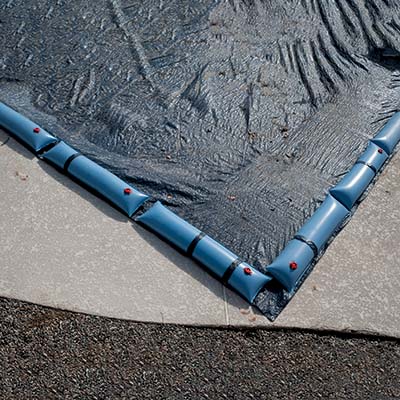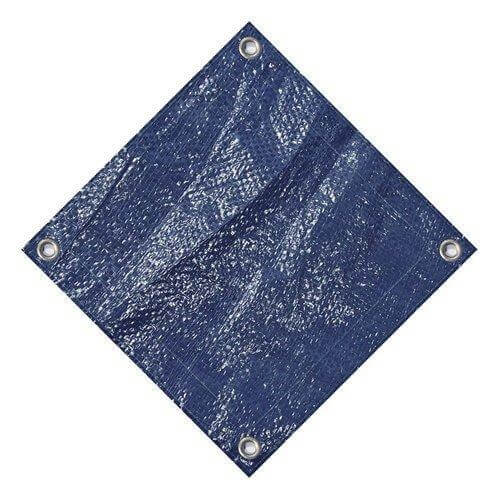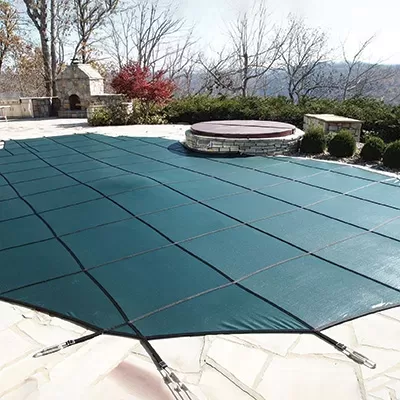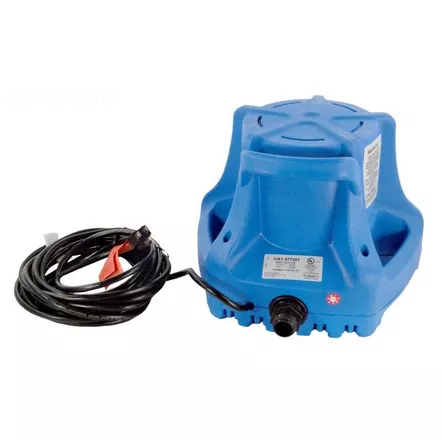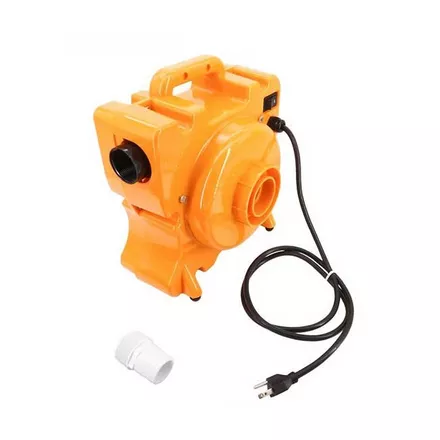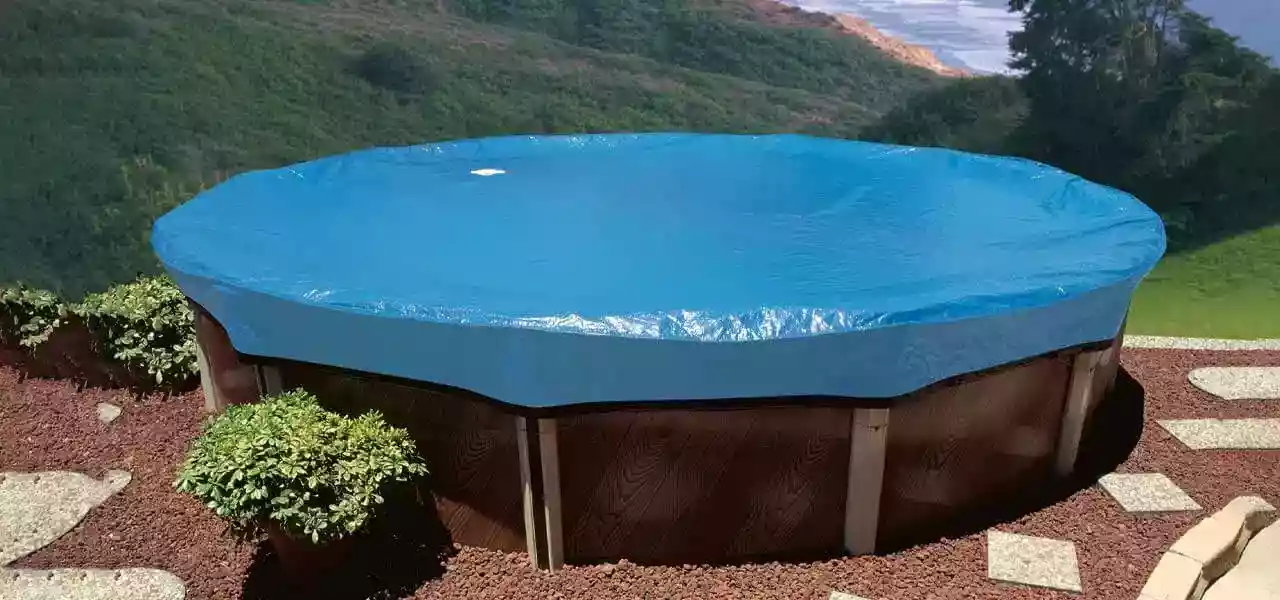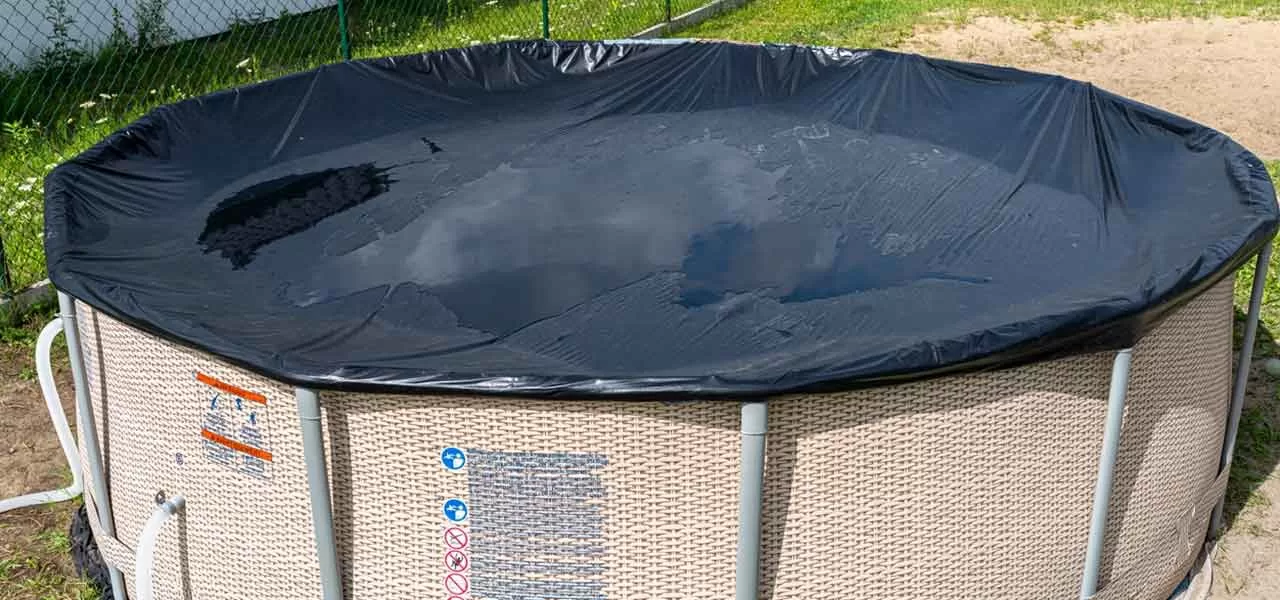
Very soon it will be time to open your pool for the spring, if you haven’t already. This is a great time to inspect your winter pool cover for damage and make any necessary repairs so you know it is ready to be used next winter.
This way you don’t have to worry about forgetting to patch in the fall, and then find yourself in an unpleasant situation if a small tear becomes a big one in the middle of next winter. Trying to make emergency repairs to a torn cover in freezing temps is no fun!
Solid Winter Cover Repairs
Solid covers (the tarp kind that lay on top of the water) are pretty easy to repair, and repairs should be done ASAP so that tears don’t stretch and get larger, allowing dirt and debris in to your pool. Tears up to about 12 inches are generally successfully repaired so that the cover can be used for at least one more season.
Tears along/near a seam can be patched, but may not last as long. Our winter cover patch kit contains two 8-1/4x 10 inch peel-and-stick patches. Just clean and dry the cover, and place the patch over the tear. Letting the patch set overnight before use would be ideal.
Other good patching options to use that you might already have around the house would be rubber cement to glue the torn areas back together, or duct tape. You had probably already thought of duct tape, is there anything it CAN’T do?!
Safety Pool Cover Repairs
DIY Repair: Tears and holes in safety covers up to 3 inches can generally be repaired at home. If you have a mesh cover and happen to have any of the safety cover mesh material you can sandwich the top and bottom of the tear with the material with rubber cement. If you have a solid cover or do not have any mesh cover material to use, we offer safety cover patch kits that come in both solid and mesh material in a variety of colors. Loop-Loc patches are made by 3M.
Each kit contains 3 peel-and-stick patches that measure 4×8 inches. For an extra-strong patch apply one to the top and bottom of the cover.

Factory Repair: If you have a tear that is over 3 inches, or broken straps, it is a good idea to check with the safety cover manufacturer to see if it is safe to repair at home or if they would recommend you send the cover in for professional repair. The manufacturer can sew on a patch, or replace the panel(s) as needed.
Measure the hole/tear and take a picture of it. You can start out by sending that information to the manufacturer to get an estimate on the repair. If you have extensive panel or strap repairs to make, you may want to consider replacement.

If you are going to send it back for professional repairs, clean and dry the cover, circle the areas that need repair with chalk, and remove the springs from the straps. Then, roll it up tightly and stuff into the smallest box that will fit, to ship it back as cheaply as possible.
You don’t have to use the original manufacturer for repair, and there are a few textile and industrial sewing companies that also repair pool safety covers.
If you don’t know who made your cover, give In The Swim a call and we can refer you to the manufacturer closest to you, for a repair quote.
WHAT IF THE POOL COVER IS NOT REPAIRED?
The ramifications of not repairing a tear in the cover – especially when the area is still repairable – is not that surprising. The tear or hole will only continue to get larger and larger until the cover is non-repairable and needing replacement.

For winter covers that float on the surface, the water will seep up through the tears and accumulate on the top of the cover. With enough weight on top, this could potentially pull the cover into the pool. Or, equally as bad, you can end up pumping the pool water out with the cover pump pulling the water through the holes in the cover! Over the years, I can’t tell you how many times I have seen winter covers pulled into the pool, or small cover holes opening up into large tears, resulting in tons of gunk spilling into the pool. What a mess!
A safety cover has a tight weave that helps prevent easy spreading of the material. Winter ice and summer sun can, however, cause the exposed fiber ends to fray, which opens up the hole more. It’s best to patch pool cover holes right away, even if they do not seem to be spreading. This helps to keep out sunlight, debris and insects.
GET ONE MORE YEAR OUT OF IT?
The best time to consider replacing your cover is either when you first open the pool or before it is time to close the pool. The cover’s age and the amount of visible wear and tear will help determine whether to replace it now or wait. However, do not make the mistake that I often hear from pool owners. “Oh, we can get one more year out of it!.” A weak cover is susceptible to winter storms, meaning it could fail during the middle of winter. If it does, it will be a nightmare to remove and replace.
CAN A POOL JUST BE UNCOVERED?
Winterized pools should be covered. Even unused sunbelt pools benefit from covering the pool during the off-season, blocking out the sun and debris. A safety cover also has huge safety benefits in addition to good looks.
An uncovered pool may bring fading or staining to the pool interior, not to mention the cleanup in the spring. The only time I recommend to remove the cover would be if the pool has a large leak that can’t be fixed during winter. But even then, I would still make sure the pool is cleaned and chemically balanced regularly.
POOL COVER MAINTENANCE
The best way to prevent cover problems from occurring is to inspect your cover as you prepare to close the pool, and periodically check it throughout the winter. If you want a pool cover to last for a long time, it needs regular maintenance to keep it as clean and dry as possible during winter.
When you open the pool, remove the cover to a clean area, hose it off, and let it dry before you put it back in a bag or bin for safe summer storage. Finally, if you routinely prune back overhanging trees from around your pool, you’ll have a much cleaner pool cover with fewer cover holes to patch. Follow these simple rules and your pool cover will last for a long time.
MY NEIGHBOR’S POOL COVER

Several years ago, my next door neighbor closed their pool in the fall with a tear in the corner and several small holes throughout the cover. I asked him before he installed the cover on the pool, “Are you going to repair it?” He replied, “It’ll be OK for another year.” I commented that I would really consider repairing it now rather than later. Once again he assured me, “It will be fine.”
Well, after about a month of wind, rain and water building up on the cover, I noticed over the fence that the tear was getting larger and the holes were getting bigger. I joked to my neighbor that he should “pump the cesspool” (remove the water off and keep the cover clean of debris). He leaned over the fence and said, “Yeah, OK. I’ll get it done this weekend. Can I borrow your patch kit?“
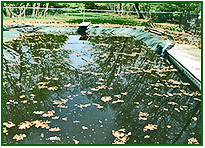
That night, the rains came. It rained for four days straight, and before he could take care of it, the cover fell into the pool. What a mess! At this point the only thing he could do is pull the cover out, letting all the water and debris fall in the pool. He tried to get the debris out of the pool, but it was impossible with the weather. When it cleared, he spent the next month of weekends trying to clean the pool. Even now, it’s still stained!
The cover was un-fixable and he had to buy a new pool cover to avoid another big mess in the pool come springtime. He was so aggravated with the “hole” situation. A simple repair before the closing the pool would have saved all this crime and punishment. Lesson learned, I guess.
I would highly recommend that you patch pool covers as early in the spring as you can so that you aren’t stressed at the end of the summer waiting for the repaired cover to be returned to you (it can take 3-4 weeks). Safety cover manufacturers are extremely busy producing new covers in the fall, and their lead times for repairs can increase to 5 or 6 weeks.



